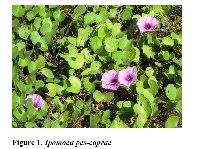Morning glory: A new thirst in-search of de-novo therapeutic approach
Keywords:
Dopatilata, Bio-active compounds, Railroad vine, Clinical trailsAbstract
Ipomoea pes-caprae (Convolvulacea) is a valuable medicinal plant, distributed in the tropics and subtropics regions and uses in folk and tribal medicines. Usually known as dopatilata, railroad vine and goat’s-foot morning glory. The plant contains active component likes naphthalenone, (-)- mellein, eugenol, 4-vinyl-guaiacol. lipophilic glycosides, 2-methylpropanoic, (2S)-methylbutyric, n-hexanoic, n-decanoic, and n-dodecanoic acids. The juice from the succulent leaves has been used as a first aid to treat jellyfish stings and also used in ritual baths to alleviate evil spells. The extract of the leaves have the astringent, diuretic and laxative properties. Leaves are used in rheumatism, and as stomachic and tonic. It has wide range of pharmacological activities like antioxidant, analgesic, anti-inflammatory, antispasmodic, antinociceptive, antihistaminic, insulogenic and hypoglycemic activities. This review focuses the published scientific evidence on its pharmacological properties, phytochemical composition, uses, along with descriptions of the plant. A number of herbal preparations are widely used in traditional system of medicine for the management of different disorders but, many of them have not been investigated for their described effects. This plant have broad spectrum activities so, further studies on other models and extensive clinical trials are needed to confirm these findings.
References
Farnsworth NR, Soejarto DD. Global importance
of medicinal plants. In: Akerele O, Heywood V.
and Synge H., Conservation of Medicinal plants.
Cambridge University Press, Cambridge. 1991.
Verpoorte R. Pharmacognosy in the New
Millennium: Lead find and Biotechnology. J
Pharmacy and Pharmacol 2000; 52: 253-262.
[3].Cordell J. Natural Product in Drug DiscoveryCreating a New Wisdom. Phytochemistry
Review, 2002; 1: 261-273.
Newman DJ, Cragg GM, Sander KM. Natural
Products as Sources of New Drugs over the
Period of 1981-2002. J Natural Products, 2003;
:1022-1037.
Harvey AL, Waterman P. The Continuing
Contribution of Biodiversity to the Drug
Discovery. Current Opinion in Drug Discovery
and Development, 1998; 1(1): 71-76.
Devall MS. The biological flora of coastal dunes
and wetlands 2. Ipomoea pes-caprae (L.) Roth. J
Coastal Research.1992; 8(2): 442-456.
Jirawongse V, Pharadai T, Tantivatana P. The
distribution of indole alkaloids in certain genera
of Convolvulaceae growing in Thailand. J
National Research Council of Thailand.1979;
:17-24.
http://en.wikipedia.org/wiki/Ipomoea pes-caprae
http://www.sms.si.edu/irLspec/Ipomoea
pesCap.htm
http://commons.wikimedia.org/wiki/Ipomoea pescaprae
Rogelio PM, Edgar ES, Carolina EM.
Characterization of lipophilic pentasaccharides
from beach morning glory (Ipomoea pes-caprae).
J Nat Prod 2005; 68(2):226-30.
Kirtikar Basu. A text book of Indian Medicinal
Plant Vol. III, second edition, fourth reprint,
Publish by Lalit Mohan Basu, Allahabad, India:
, p 1726
Premanathan M, Nakashima H, Kathiresan K,
Rajendran N, Yamamoto N. In vitro anti human
immuno deficiency virus activity of mangrove
plants. Indian J Medical Research 1996; 130:
-279.
Pongprayoon U, Bohlin L, Baeckstrom P,
Jacobsson U, Lindstrom M, Soonthornsaratune P,
Wasuwat S. Anti-Inflammatory activity of
Ipomoea pes-caprae. Planta Med 1990; 56
(6):661.
Marcia M de Souza, Alexandre M, Cristine B,
Renata K, Rosendo A. Yunes and Valdir
Cechinel-Filho. Antinociceptive properties of the
methanolic extract obtained from Ipomoea pescaprae (L.) R. Br. J Ethnopharmacol 2000; 69
(1):85-90.
Govindasamy Agoramoorthy, Fu-An Chen,
Venugopalan Venkatesalu, Daih-Huang Kuo, PoChuen Shea. Evaluation of Antioxidant
Polyphenols from Selected Mangrove Plants of
India. Asian J Chemistry 2008; 20: 1311-1322.
Pongprayoon U, Baeckstrom P, Jacobsson U,
Lindstrom M, Bohlin L. Antispasmodic activity
of beta-damascenone and E-phytol isolated from
Ipomoea pes-caprae. Planta Medica 1992;
(1):19-21.
Pongprayoon U, Bohlin L, Wasuwat S.
Neutralization of toxic effects of different crude
jellyfish venoms by an extract of Ipomoea pescaprae (L.) R. Br. J. Ethnopharmacol. 1991;
:65-9.
Pongprayoon U, Baeckstrom P, Jacobsson U,
Lindstrom M, Bohlin L. Inhibition of ethyl
phenylpropiolate-induced rat ear oedema by
compounds isolated from Ipomoeae pes-caprae
(L.) R. Br. Phytother research 1992; 6 (2):104-
Pongprayoon U, Bohlin L, Sandberg F, Wasuwat
S. Inhibitory effect of extract of Ipomoea pescaprae on guinea-pig ileal smooth muscle. Acta
Pharm Nord 1989; 1 (1): 41-4.



